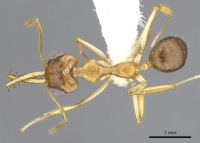Myrmoteras chondrogastrum
| Myrmoteras chondrogastrum | |
|---|---|

| |
| Scientific classification | |
| Kingdom: | Animalia |
| Phylum: | Arthropoda |
| Class: | Insecta |
| Order: | Hymenoptera |
| Family: | Formicidae |
| Subfamily: | Formicinae |
| Tribe: | Myrmoteratini |
| Genus: | Myrmoteras |
| Species: | M. chondrogastrum |
| Binomial name | |
| Myrmoteras chondrogastrum Moffett, 1985 | |
Nothing is known about the biology of Myrmoteras chondrogastrum.
Identification
Moffett (1985) - Similar to Myrmoteras donisthorpei, but the granulate sculpture on the gaster is unique to this species.
Keys including this Species
Distribution
Latitudinal Distribution Pattern
Latitudinal Range: 4.95° to 4.95°.
| North Temperate |
North Subtropical |
Tropical | South Subtropical |
South Temperate |
- Source: AntMaps
Distribution based on Regional Taxon Lists
Indo-Australian Region: Borneo (type locality), Indonesia, Malaysia.
Distribution based on AntMaps
Distribution based on AntWeb specimens
Check data from AntWeb
Countries Occupied
| Number of countries occupied by this species based on AntWiki Regional Taxon Lists. In general, fewer countries occupied indicates a narrower range, while more countries indicates a more widespread species. |

|
Estimated Abundance
| Relative abundance based on number of AntMaps records per species (this species within the purple bar). Fewer records (to the left) indicates a less abundant/encountered species while more records (to the right) indicates more abundant/encountered species. |

|
Biology
Castes
Nomenclature
The following information is derived from Barry Bolton's Online Catalogue of the Ants of the World.
- chondrogastrum. Myrmoteras (Myagroteras) chondrogastrum Moffett, 1985b: 39, figs. 31, 34 (w.q.) BORNEO.
Unless otherwise noted the text for the remainder of this section is reported from the publication that includes the original description.
Description
Worker
Holotype: TL 5.3 (est.), HW 0.94, HL 1.00 (CI 94), ML unknown (tips broken), SL 1.12 (SI 119), EL 0.66, HFL 1.20 (TWI 19), WL 1.45 mm. Frontal sulcus a wide trench, somewhat wider than in M. donisthorpei (wider midway between epistomal suture and ocelli than diameter of median ocellus); orbital furrows conspicuous. Frontal area clearly defined. Palpal segmentation 5,4. Mandibles with tips broken, probably originally with 12 teeth and 2 preapical denticles, as in queen; condition of apical denticles unknown (in the queen each mandible has a single stout apical denticle). Dorsum of mandibles with a medial groove as in Myrmoteras morowali, but groove more feeble and extending only as far as fourth or fifth tooth from base.
Pronotum low and evenly convex; propodeum somewhat flattened dorsad, although feebly evenly convex, and with summit virtually level with mesonotum. In profile node of petiole with anterior and posterior faces straight, anterior face steep but not vertical, posterior face not as steep, curving more gently into summit; summit narrow. Middle and hind tibiae less dilated than in M. donisthorpei.
Head finely granulo-rugose, rugae between 0.01 to 0.02 mm across; posterior to median ocellus and beneath head smooth; smooth laterally except for fine vertical rugae near eyes. Frontal area and clypeus feebly granulate. Pronotum granulate, smoother laterally and with transverse rugae near neck; mesonotum with a ruga extending forward from each tubercle, very feebly granulo-rugose dorsally and longitudinally rugose laterally; dorsally propodeum with fine and very feeble transverse rugae, declivity and sides virtually smooth. Gaster very finely and irregularly granulate dorsally; laterally more feebly sculptured and smooth ventrad. Hair density moderate, with 25 hairs breaking dorsal margin of trunk when viewed in profile. Hairs short, rising 0.08 mm on head and 0.10 mm on trunk and gaster; two to five hairs on or near each metathoracic tubercle and six on node of petiole. Head orange; trunk, petiole, and mandibles orange yellow; gaster brownish orange; antennae yellowish orange; legs very light yellow.
Queen
Paratype: TL 5.6, HW 1.00, HL 1.03 (CI 97), ML 1.45 (MI 141), SL 1.15 (SI 116), EL 0.66, HFL 1.23 (TWI 18), WL 1.48 mm. Trunk dorsally with feeble granulate sculpture, tending towards longitudinally granulo-rugose medially on mesonotum; smooth laterally. Propodeum transversely rugose dorsally and obliquely rugose on sides, rugae ca. 0.15 mm apart; declivity smooth.
Type Material
Holotype. Worker deposited in The Natural History Museum from Borneo: Sarawak: 4th Division, Gunung Mulu National Park, v-viii.l978, no. 49 (P. M. Hammond and J. E. Marshall B. M. 1978). Single dealate queen, same date and collection number as holotype (Museum of Comparative Zoology).
Etymology
The specific name derived from Gr. chondros + gaster, referring to the granulate sculpture on the gaster.
References
- Moffett, M.W. 1985b. Revision of the genus Myrmoteras (Hymenoptera: Formicidae). Bulletin of the Museum of Comparative Zoology. 151:1-53. (page 39, figs. 31, 34 worker, queen described)
References based on Global Ant Biodiversity Informatics
- Agosti D. 1992. Revision of the ant genus Myrmoteras of the Malay Archipelago (Hymenoptera, Formicidae). Rev. Suisse Zool. 99: 405-429.
- Agosti, D. 1992. Revision of the ant genus Myrmoteras of the Malay Archipelago (Hymenoptera, Formicidae). Rev. Suisse Zool. 99: 405-429
- Moffett M.W. 1985. Revision of the genus Myrmoteras. Bulletin of the Museum of Comparative Zoology 151: 1-53.
- Pfeiffer M., and D. Mezger. 2012. Biodiversity Assessment in Incomplete Inventories: Leaf Litter Ant Communities in Several Types of Bornean Rain Forest. PLoS ONE 7(7): e40729. doi:10.1371/journal.pone.0040868
- Pfeiffer M.; Mezger, D.; Hosoishi, S.; Bakhtiar, E. Y.; Kohout, R. J. 2011. The Formicidae of Borneo (Insecta: Hymenoptera): a preliminary species list. Asian Myrmecology 4:9-58
- Zettel H., and Sorger, D. M. 2011. New Myrmoteras ants (Hymenoptera: Formicidae) from the southeastern Philippines. Raffles Bulletin of Zoology 59:61-67.

